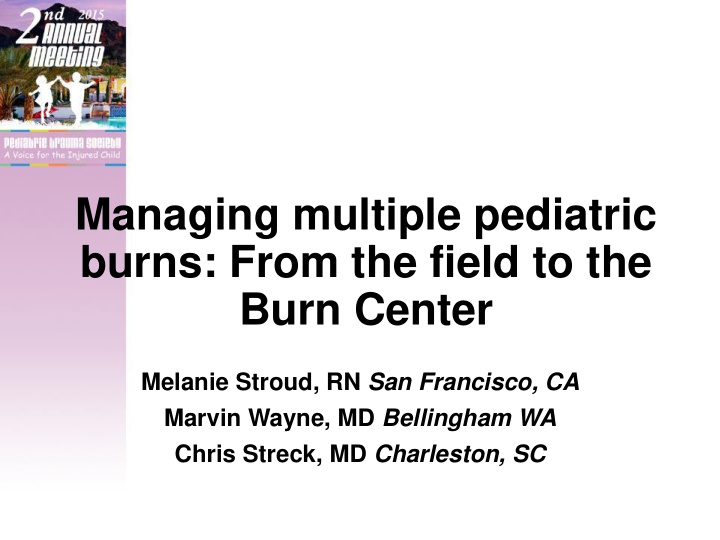



Managing multiple pediatric burns: From the field to the Burn Center Melanie Stroud, RN San Francisco, CA Marvin Wayne, MD Bellingham WA Chris Streck, MD Charleston, SC
The Statistics Burns account for >300,000 deaths yr worldwide In U.S., they are the third leading cause of fatal home injuries Death usually results from the inhalation injury. Of 25 developed countries US mortality is eighth Major risk factors; extremes of age, alcohol (in 40% of deaths) and substandard housing.
The Statistics >60% are thermal, the majority of others being chemical and radiation Electrical burns, infrequent but require important considerations. Morbidity and mortality increase with both depth and extent. Prehospital, and early hospital treatment can decrease future disability and mortality.
Jan anuary uary 1, 1, 20 2012 12 4: 4:22 22 hr hrs
CASE SCENARIO- 2 Burn Patients in a community hospital Space heater house fire Pt 1: 11 y/o F 22% Deep 2 nd and 3 rd Degree Burns to L face/ head, L chest, L arm, R arm, both hands Respiratory distress with CO >40% Pt. 2: 4 y/o 20% 3 rd degree burns to face/head, bilateral hands. Respiratory distress CO >30% Transported to community hospital for stabilization- Nearest Pediatric Level I Burn Center is 1 ½ hours away
Pt 1 Prehospital: Obvious airway concerns with carbonatious sputum CO level of >40%. Pt very somnolent. Burned clothing quickly removed IV rapidly established fluids started. IV, Dilaudid, versed and pt preoxygenated, intubated in back of EMS unit.
Pt 2 Prehospital: Also with airway concerns, carbonatious sputum CO >30% Burned clothing removed and IO line placed. Dilaudid and versed followed by intubation in EMS Unit.
Resuscitation Audience Question? What are the main considerations in Resuscitation?
Resuscitation Airway Breathing Circulation Disability Exposure
Primary and Secondary Survey Airway: Early recognition of airway compromise prompt intubation If soot in the mouth consider early intubation even if the patient appears to be breathing normally. Breathing: Determine if patient is moving air. Circulation: Obtain vascular access and monitor Disability: Detect if other injures or neurologic deficits. Exposure: Completely exposed (while keeping warm). Exposure: All orifices must examined
Primary and Secondary Survey Fluid resuscitation: A mainstay in the treatment. Discussed in third question after the calculation %TBSA Guidelines of Acute Trauma Life Support (ATLS) should be followed Note child is prone to hypothermia due to high surface to volume ratio and low fat mass. Ambient temperature should be from 28 ° to 32 ° C(82 ° to 90 ° F). Patient’s core temperature must be kept at least above 34 ° C.
Primary and Secondary Survey Secondary survey is a burn-specific survey. performed during admission to the burn unit. Full history should include: Detection of the mechanism of injury. Time of injury. Consideration of abuse.
Primary and Secondary Survey Height and weight. Possibility of carbon monoxide intoxication based on history of a closed space, presence of soot in mouth and nose. Where there is high CO, think Hydrogen Cyanide Facial burns. Examination of the cornea and ear in case of explosion A systemic overview should be performed including EFAST, exam genital region, lower and upper extremities (think: X-Ray C-Spine, Thorax, and Pelvic). Consider abuse if history unclear.
Inhalation Injury Signs of potential inhalation injury include : Facial burns Singed nasal hairs Carbonaceous sputum Abnormal mental status Respiratory distress ( dyspnea, wheezing, stridor) Elevated carboxy- hemoglobin levels
Audience Question? What are the indications for intubation, acutely, and prior to transfer?
Indications for Intubation Pediatric Burns - Indications for Intubation Closed space injury Loss of consciousness ↑ carboxyhemoglobin Hypoxia, hypercapnea Acidosis Burns > 30% TBSA Prolonged air transport Carbonaceous sputum Hoarseness Stridor Burns to face, head, neck Singed hair Tachypnea
Transfer to a Burn Unit Audience Question: Does the patient meet the criteria for injuries requiring referral to the Burn Unit?
Transfer Guidelines Burn injuries that should be referred to a burn center include the following: Airway burns Partial-thickness burns greater than 10% Burns that involve face, hands, feet, genitalia, perineum, or major joints. Third-degree burns in any age group. Electrical burns, including lightning injury. Chemical burns.
Estimating Burns Audience Question: What is the best scale to use when estimating burn areas in children?
Estimating Burns in Children Lund and Browder chart Compensates for variation in body shape, age Gives accurate assessment of burns in children Expose and evaluate sequentially
CASE SCENARIO- 2 Burn Patients in a community hospital
Fluid Resuscitation Audience Question: What percent burn should receive fluid resuscitation, using what formula?
Fluid Resuscitation Burns greater than 20% TBSA associated with Increased capillary permeability and intravascular volume deficits Are most severe in the first 24hours following injury. Optimal fluid resuscitation: Support organ and tissue perfusion at the least physiological cost (edema/capillary leak)
Fluid Resuscitation
Fluid Resuscitation 6 – 12 years 3 – 5 years 0 – 2 years 0.5 – 1 mL / kg 1 mL / kg 1.5 – 2 mL / kg Larger burns often need a Foley
Audience question: What kind of laboratory tests should be performed?
Labs What kind of laboratory tests should be done? BMP Hct UA ABG/CO Albumin/pre-albumin CXR
How to care for the Burns? Audience Question: What is the best way to care for burn wounds prior to transport?
Covering the Burn Providers should remove clothing around the burn Cover burns with a clean dry sheet and keep patients warm. Kerlix is another good option Don’t need to spend time rupturing blisters
Audience question? Who needs escharotomy prior to transfer?
Audience question? Who needs HBO2?
Other early considerations • Debridement and coverage • Biobrane, Xeroform, Mepitel AG, EZ Derm
Audience question? • Colloid? • Tetanus?
Audience question? • When to start enteral nutrition?
Other early considerations • Associated traumatic injuries • Child abuse/neglect
Uniform Burn Depth Skin Sparing “ Dougnut hole” Sparing of the creases Uniform burn line demarcation
Thank you! Questions?
Recommend
More recommend